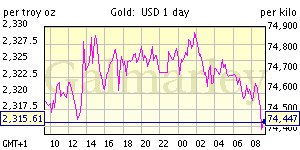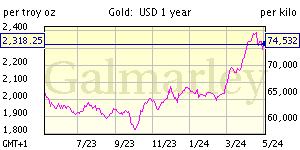
30-Aug (USAGOLD) — Gold remains consolidative to mildly corrective. While recent housing data took a little wind out of the sails of the QE3 advocates, the Atlanta Fed’s Lockhart seemed to suggest on CNBC today that additional measures were indeed going to be forthcoming…it was just a matter of timing.
Lockhart said that more easing in September was going to be a “close call,” reiterating that action was data dependent in saying, “If we were to see deterioration from this point, let’s say a persistence of job growth numbers that were well below 100,000 per month, or see signs of disinflation that could signal the onset of deflation, then there wouldn’t be much of a question about policy.” Those data have not been quite that bad of late, suggesting perhaps the Fed might indeed be looking to keep its powder dry for the time being.
Nonetheless, the market will be hanging on Bernanke’s every word when he speaks in Jackson Hole on Friday. They’ll be hoping to glean additional clues as to the likelihood of further Fed measures in September, or whether they should just start looking forward to the October FOMC meeting.
Our own Mike Kosares, wrote a couple really good posts on the Breaking News Page yesterday on the topic of QE3:
One man’s opinion on Bernanke’s QE3 quandary
Follow up question: How would the lack of QE3 affect the gold market?
As I’ve stated in the past, the direction gold ultimately takes is not wholly dependent on whether there is a QE3 or not. Mike apparently agrees, calling QE3 a “huge distraction and a short term consideration that takes away from the real reasons why the gold price might rise in the years to come.”
The speculation about additional ECB measures continues to rage as well. Both business and consumer confidence in the eurozone plunged to 3-year lows in August, upping the pressure on ECB chief Mario Draghi to find a way to provide additional stimulus without enraging core-Europe…and specifically the Germans.
• US initial jobless claims UNCH at 374k for the week ended 25-Aug, above expectations of 370k, vs upward revised 374k in the previous week.
• US personal income +0.3% in Jul, in-line with expectations, vs negative revised +0.3% (from +0.5%) in Jun.
• US PCE +0.4% in Jul, in-line with expectations, vs UNCH in Jun.
• German unemployment (sa) steady at 6.8% in Aug, in-line with expectations.
• Eurozone economic confidence fell to 86.1 in Aug, below expectations of 87.6, vs 87.9 in Jul.
• Eurozone consumer confidence confirmed at -24.6 in Aug.
• Eurozone industrial confidence fell to -15.3 in Aug, below expectations of -15.0, vs negative revised -15.1 in Jul.
• Eurozone business climate improved to -1.21 in Aug, on expectations of -1.30, vs -1.27 in Jul.
• Eurozone services confidence fell to -10.8 in Aug, below expectations of -9.0, vs -8.5 in Jul.
• Japan large retailer sales Y/Y JUL -4.4% y/y in Jul, vs -2.6% y/y in Jun; total retail sales -0.8% y/y.











